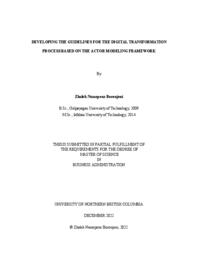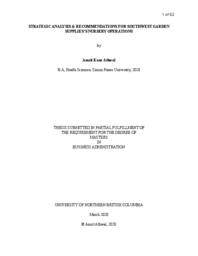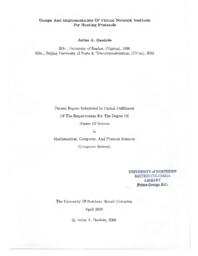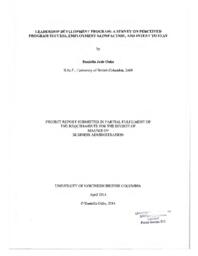Bankole, Julius
Person Preferred Name
Julius Bankole
Related Works
Content type
Digital Document
Description / Synopsis
Many companies use information systems to support their operations, but to properly utilize IS, organizations must go through a Digital Transformation (DT) process. One of the strategic assets needed to begin or accelerate the DT journey is Dynamic Capabilities (DC). Despite the progress that DT has achieved in understanding the contributions of individuals to the construction and maintenance of DC, there have been requests to engage more deeply with the nature of the work performed by actors who support these capabilities. Therefore, we focus on the actors' roles in DC and use the Actor Modeling Framework to connect actors to DC. Then we developed a guideline by using a design-science approach to connect different parts of DT, and its application was tested in Prince George, Red Deer, and Grande Prairie EDOs. The guideline is like a clear map showing EDO organizations where they need to go to implement DT.
Origin Information
Content type
Digital Document
Description / Synopsis
Southwest Garden Supplies is a garden centre which is undergoing growth in its sales in both of its departments: nursery and bulk garden/landscape materials. With the increasing quantity, and sales of plants, the company requires strategic analysis and recommendations to improve its nursery operations. Some factors which require improvement are: a lack of enough employees, and two, a lack of systematic processes required in the maintenance, and sale of plants. Because only family members work at the nursery, and maintain the rest of the enterprise, there are more tasks which need to be accomplished than there are hands. Southwest Garden Supplies is in the process of hiring new employees, and approximately three new employees shall commence work in the foreseeable future. As of now, tasks like fertilizing, efficient watering, weeding, and pruning are not being executed in a systematic manner. Therefore, a lot of the plants are not optimally maintained. Due to a lack of organization, and time, pricing is a complex matter of hardship. As of now, there are minimal price tags placed on plants. Only the administrator in charge of the nursery knows the prices. Therefore, if she is not around for whatever reason, the remaining staff do not know how to price the plants. During the summer, watering by hand takes a minimum of three hours per day, that too after office hours; meaning the family leaves work close to 9:00pm, only to start again at 7:00am the next morning. This watering process leaves the other tasks of plant maintenance incomplete. As discussed, the nursery division of the garden centre needs to be run optimally. The purpose of this paper is to undertake research on how the nursery can be maintained efficiently, including how plant inventory can be best managed, and how the administration staff can maintain healthy relationships with the new employees. Human resource management will be discussed due to the importance of increased employee loyalty and decreased employee attrition. Results/Recommendations shall be made as to what steps need to be taken in order to streamline the nursery maintenance processes for the staff, and make shopping at Southwest Garden Supplies more fluid, and straightforward.
Origin Information
Content type
Digital Document
Description / Synopsis
Business intelligence tools allows for data-driven decision-making within organizations using historical events to predict future trends, which is especially valuable when allocating operational resources. As a research-intensive Canadian university, UNBC has seen a significant increase in activities related to supporting the research enterprise, which requires additional resources (human, capital, financial etc.) in order to effectively and efficiently advance the mission of the research community. As outlined in our Annual University Accountability Report, 2018/19 was an incredibly productive year for research with more than $14 million received in support of research. The University has seen a significant increase in the number and breadth of agencies and organizations funding research at UNBC. The administration of research awards involves both pre-award and post-award processes, which requires responsible allocation of available resources to ensure a sustainable model will be developed to achieve goals outlined by the institution’s strategic priorities and build the foundation to reach our goal of a research enterprise generating $25M in annual research revenue. Therefore, using business intelligence tools to utilize historical data to predict the necessary resourcing needs of the institution will allow UNBC to make strategic investments in research and remain competitive on the provincial, national and international stage. Informed decision-making when investing resources are critical to the success of any business. The goal of my MBA project is to gather critical information to be used in the development a data visualization and forecasting tool that will allow for informed decisions for the allocation of resources necessary to support the research mission at UNBC. The objectives of the MBA project are two-fold, which include the development of the business case for the UNBC data visualization tool (DVT) and also the completion of a design document. The information gathered6 from this project will be used in the future (post-MBA) to develop a data visualization tool that will allow for the on-going monitoring of UNBC’s progress towards putting in place the appropriate resources to reach $25M in annual research revenue. Specifically, the MBA project will consist of completing a comprehensive business case outlining the “business need” and potential solutions. Secondly, the MBA project will consist of developing a “design document” for an eventual tool that will be used to visualize research funding and labor information to inform business decisions for resource planning for the UNBC research enterprise. This design support system will be used by senior leadership within UNBC to effectively and efficiently make decisions to allocate resources.
Origin Information
Content type
Digital Document
Origin Information
Content type
Digital Document
Origin Information





